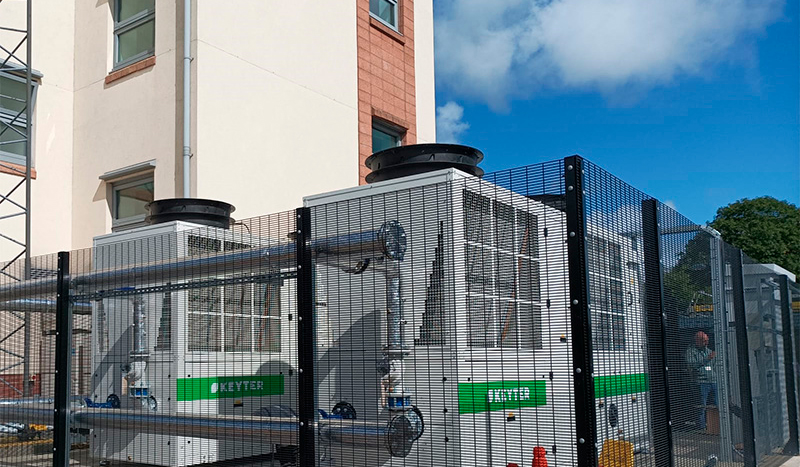2025 Regulatory and Normative Changes in the Air Conditioning and Refrigeration Sector
Eco-Design Regulation, F-Gas, RSIF, EPBD, RITE… The HVAC&R sector is experiencing a pivotal phase, marked by updates to several key regulatory texts that will shape its future. This article examines the anticipated changes to these regulations over the course of this year.
We are currently in a period of significant updates to the regulatory and normative framework affecting the HVAC&R sector, including: RSIF (Safety Regulations for Refrigeration Installations); F-Gas Regulation (EU Regulation on Fluorinated Gases); EPBD (Energy Performance of Buildings Directive); Eco-Design Regulation; and RITE (Regulation on Thermal Installations in Buildings).
In this article, we’ll highlight some of the key points where modifications are being made:

Safety Regulations for Refrigeration Installations (RSIF)
Royal Decree 552/2019 of 27 September, approving the Safety Regulations for Refrigeration Installations and its complementary technical instructions, will undergo amendments aimed at:
- Aligning with EU refrigerant and energy-efficiency standards, updating the Regulation’s technical requirements.
- Tightening periodic inspections to further ensure installation safety.
- Expanding maintenance obligations for refrigeration systems, enforcing stricter protocols.
- Introducing more rigorous technical criteria for the use of new A2L and A3 safety-group refrigerants.
- Establishing new professional certifications for refrigerant handling—likely up to six distinct categories with dedicated modules for NH₃, CO₂, etc.
All of this with a focus on the emerging R290 installations, which have revealed that this regulation was not prepared for the widespread use of A3 refrigerants.
Fluorinated Greenhouse Gases Regulation (F-Gas Regulation)
Regulation (EU) 2024/573 of the European Parliament and of the Council of 7 February 2024 on fluorinated greenhouse gases—which amends Directive (EU) 2019/1937 and repeals Regulation (EU) No 517/2014—has already been updated. Let’s recap:
Correction of errors:
- Correction of errors to Regulation (EU) 2024/573 (28 February 2024) of the European Parliament and of the Council of 7 February 2024 on fluorinated greenhouse gases, which amends Directive (EU) 2019/1937 and repeals Regulation (EU) No 517/2014.
- Correction of errors to Regulation (EU) 2024/573 (17 December 2024) of the European Parliament and of the Council of 7 February 2024 on fluorinated greenhouse gases, which amends Directive (EU) 2019/1937 and repeals Regulation (EU) No 517/2014.
- Correction of errors to Regulation (EU) 2024/573 (24 March 2025) of the European Parliament and of the Council of 7 February 2024 on fluorinated greenhouse gases, which amends Directive (EU) 2019/1937 and repeals Regulation (EU) No 517/2014.
Implementing Regulations:
- Commission Implementing Regulation (EU) 2024/2195 (5 September 2024) of 4 September 2024, laying down the format for the transmission of data notifications referred to in Article 26 of Regulation (EU) 2024/573 of the European Parliament and of the Council on fluorinated greenhouse gases, and repealing Commission Implementing Regulation (EU) No 1191/2014.
- Commission Implementing Regulation (EU) 2024/2215 (9 September 2024) of 6 September 2024, establishing, in accordance with Regulation (EU) 2024/573 of the European Parliament and of the Council, the minimum requirements for the issuance of certificates to natural and legal persons…
Exemptions:
- Commission Implementing Regulation (EU) 2024/3122 (17 December 2024) of 16 December 2024, authorising an exemption under Regulation (EU) 2024/573 of the European Parliament and of the Council concerning the use of fluorinated greenhouse gases with a GWP equal to or greater than 150 in blood transport containers and plasma-contact shock freezers.
- Commission Implementing Regulation (EU) 2024/3120 (17 December 2024) of 16 December 2024, authorising an exemption under Regulation (EU) 2024/573 of the European Parliament and of the Council concerning the use of fluorinated greenhouse gases with a GWP equal to or greater than 150 in mechanical cryogenic freezers (– 150 °C).
Without a doubt, the list will grow in the coming months. As I’ve pointed out several times, the F-Gas Regulation raised more questions than answers, and bit by bit those will be addressed.
We understand that the major changes will stem from the exemptions and moratoriums that must be imposed to prevent the sector from collapsing. Looking back, one of the first impressions we all had when analyzing the F-Gas Regulation was the extremely short implementation deadlines it imposed.
Another critical point to clarify under the F-Gas Regulation is professional certifications—the much-discussed Article 10—which is already in sight but still undefined in the proposal laid out by Commission Implementing Regulation (EU) 2024/2215 of 6 September 2024, where the six proposed certificates and their syllabi are established:
- Certificate A1: certifies that the holder may carry out all activities listed in Article 2(1) related to fluorinated greenhouse gases and hydrocarbons.
- Certificate A2: certifies that the holder may carry out all activities listed in Article 2(1) related to fluorinated greenhouse gases and hydrocarbons, limited to equipment with a charge size below 3 kg or, for hermetically sealed and labelled systems, containing less than 6 kg.
- Certificate B: certifies that the holder may carry out all activities listed in Article 2(1) related to carbon dioxide (CO₂).
- Certificate C: certifies that the holder may carry out all activities listed in Article 2(1) related to ammonia (NH₃).
- Certificate D: certifies that the holder may carry out the activity referred to in Article 2(1)(d) on equipment containing less than 3 kg of fluorinated greenhouse gases or, for hermetically sealed and labelled systems, containing less than 6 kg of such gases.
- Certificate E: certifies that the holder may carry out the activity referred to in Article 2(1)(a), provided it does not involve accessing a refrigeration circuit containing the fluorinated greenhouse gases listed in Annex I and in Annex II, Section 1, of Regulation (EU) 2024/573.
Energy Performance of Buildings Directive (EPBD)
Directive (EU) 2024/1275 of the European Parliament and of the Council, of 24 April 2024, on the energy performance of buildings has yet to see any sequel—but you can bet it’s just around the corner.
In its Annex I, “Common Framework for Calculating the Energy Performance of Buildings,” it already signals the intention to harmonize methods across Member States.
And, going a step further, the long-overdue update of Primary Energy Factors that currently penalize heat-pump performance in all its formats and applications.
All in all, a whole new world to explore.
Eco-Design Regulation
Regulation (EU) 2024/1781 of the European Parliament and of the Council of 13 June 2024, which establishes a framework for setting ecodesign requirements applicable to sustainable products, amends Directive (EU) 2020/1828 and Regulation (EU) 2023/1542, and repeals Directive 2009/125/EC, will continue to evolve and periodically introduce updates to the current Ecodesign and Labelling Regulations.
Among the most recent:
- Commission Delegated Regulation (EU) 2023/2048 of 4 July 2023, amending Delegated Regulations (EU) No 626/2011, (EU) 2019/2015, (EU) 2019/2016 and (EU) 2019/2018 as regards the energy-labelling requirements for air conditioners, light sources, household refrigerating appliances and refrigerating appliances with a direct-sales function.
- Commission Implementing Regulation (EU) 2024/1834 of 3 July 2024, implementing Directive 2009/125/EC of the European Parliament and of the Council with regard to ecodesign requirements for fans driven by motors with an electric input power between 125 W and 500 kW, and repealing Commission Regulation (EU) No 327/2011.
Regulation on Thermal Installations in Buildings (RITE)
Finally, Royal Decree 1027/2007 of 20 July, approving the Regulation on Thermal Installations in Buildings, will be amended—many changes stemming from the RSIF. Bear in mind that HVAC installations must first comply with the RSIF before RITE; accordingly, every amendment to the former impacts RITE, even if it doesn’t alter its actual text.
In addition, it will inherit the F-Gas, EPBD, and other amendments, meaning it will be the most heavily impacted. You can almost sense it will roll out in phases, rather than undergo a single comprehensive overhaul.
However, there are indeed changes impacting RITE’s approach to system design:
- Space ventilation: The inclusion of UNE EN 16798-1, -3 and -17 means that, beyond human occupancy, ventilation rate calculations must now consider the building itself—its structural elements, finishes and furnishings.
- Maintenance & inspections: These will be aligned with the updates in the regulations we’ve already covered.
- DHW generation: The EPBD and the revised Primary Energy Factors will reshape heat-pump specifications, building load profiles and, ultimately, design strategies.
Commitment to Sustainability and Regulatory Compliance
To meet current regulations—and go beyond them—KEYTER, a manufacturer of air-conditioning and refrigeration solutions, has spent years researching and innovating. The company’s mission is to design and build efficient, sustainable HVAC equipment tailored to the specific needs of each application and client.
In this way, its solutions guarantee full compliance with the strictest standards—such as the Eco-Design Regulation and the Energy Performance of Buildings Directive—while delivering added value through sustainability and energy efficiency, contributing to the sector’s decarbonization and aligning with future trends.
More articles
Interested in other (technical) knowledge articles? Keep yourself up to date and read them all

